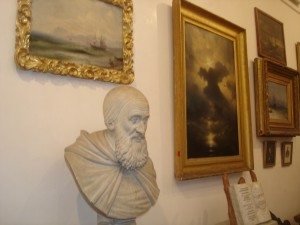By Levon A. Saryan
We stepped into the water taxi at dockside, just a block away from Venice’s lively Piazza di San Marco. Some other passengers climbed aboard, and the noisy vaporettoset off across the tranquil water. Twenty minutes later, we were deposited at San Lazzaro Degli Armeni, a tiny “Armenian” island in the middle of the Venetian lagoon.

A few seconds after we disembarked, the boat sped off, and rather suddenly we were enveloped in silence. It was as if we had been transported to another world. My first impression was a feeling of serenity, stillness, and solitude, a world far removed from and far different than the noisy bustling city we had left behind moments before.
My wife Shirley and I were celebrating our 25th anniversary with a long awaited and much anticipated Mediterranean cruise on the ocean liner Crystal Serenity. First Athens, then Split (Croatia), then Italy with stops in Venice, Sorrento, Rome, and Florence, and finally Monte Carlo and Nice. While planning the seven-country itinerary, Shirley mentioned that we would have two days in Venice. I immediately agreed; one of my lifelong desires had been to visit the monastery of San Lazzaro, and on Oct. 27, 2006, that dream came to fruition.
For more than three centuries, the island of San Lazzaro has been the home of the Armenian monks of the Mekhitarist order—gentle, soft-spoken men devoted to God, who labor diligently to bring the light of Christianity to the Armenian nation. Founded by Mekhitar Sepastatsi in 1701, the order has ever since stood for the harmonious fusion of Armenia’s Christian faith with devotion to the riches of the Armenian heritage. For the Mekhitarists, faith and patriotism—God and nation—are inseparably intertwined.

Mekhitar was born in 1676 in Sepastia, a city in Western Armenia with a large Armenian population. As a young man he desired to devote himself to the service of our Lord and sought higher education for this purpose. He travelled widely seeking enlightenment, finally reaching Constantinople, which at that time was the center of Armenian life in Turkey. The suffocating despotism that prevailed in Ottoman Turkey in those days, however, proved to be a major obstacle.
Sensing he would be unable to achieve his aim in the capital city, Mekhitar converted to Roman Catholicism and left Constantinople for the Morea (the Peloponnesian Peninsula), which was then under the control of Venice. He gathered around him a group of nine like-minded young men and in 1701 founded an order of monks following the Benedictine model. Just as he began his teaching mission, the Turks overran the Morea (1715) forcing Mekhitar and his followers to flee to Venice.
In Venice, the beleaguered abbot appealed to city authorities for assistance. In 1717, the doge of Venice granted the order, in perpetuity, a tiny uninhabited island in the lagoon. At one time, San Lazzaro had been home to a leper colony, but had long since been abandoned. A church and a few buildings on the island lay in ruins.
With this inauspicious start, the monks set to work turning the desolate patch of land not much larger than a couple of football fields into a busy monastic complex. Over a period of several decades, they enlarged the island’s landmass, rebuilt the church, erected monastic buildings, and established a school. Now safe from the threat of Turkish interference, the monks embarked vigorously on their intellectual work. They gathered an incomparable library with thousands of original manuscripts and over 150,000 printed books and periodicals, and an eclectic museum collection of ancient antiquities. Most significantly, they established a very active printing press, and used the press to disseminate the results of their scholarly investigations.
Indeed, for the past three centuries industrious work has been the hallmark of the monks of the Mekhitarist order. Instead of cursing the darkness, they lit candles, beacons for the enlightenment of the Armenian nation. They established schools in many cities of the Armenian Diaspora. The printing house aggressively turned out Bibles and religious tracts, translations of European classics into Armenian, volumes of ancient classical texts preserved only in Armenian translated into European languages, and original works on the Armenian language and history, geography, art, antiquities, and much more. More than any other single Armenian institution, even more than our national church, during the 19th century it was the Mekhitarist intellectual torch that lifted our nation out of the swamp of Turkish tyranny into which we had been plunged.
To be continued…
Dr. Levon Saryan has been writing for the Armenian Weekly for 40 years. He lives in Greenfield, Wisc.



Dr. Saryan, we are doing the reverse cruise of yours and will visit San Lazzaro on Sunday, Oct. 2, 2011. Is there a way to contact them? Your articles make us anxious to see their treasures and experience the island. Thank you for that!